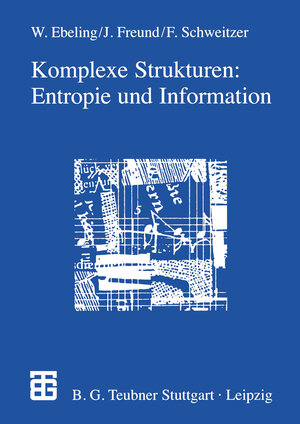
×
![Buchcover ISBN 9783322851680]()
Komplexe Strukturen: Entropie und Information
von Jan Freund und Frank Schweitzer, mit Werner EbelingInhaltsverzeichnis
- 1 Komplexität und Entropie.
- 1.1 Struktur und Ordnung.
- 1.2 Was sind komplexe Strukturen?.
- 1.3 Komplexität als Phänomen.
- 1.4 Quantifizierimg der Komplexität.
- 1.5 Thermodynamische Entropie.
- 1.6 Statistische und informationstheoretisehe Entropie.
- 1.7 Entropie und Vorhersagbarkeit.
- 2 Selbstorganisation und Information.
- 2.1 Entropie und potentielle Information.
- 2.2 Entropie und Selbstorganisation.
- 2.3 Zur Evolution der Informationsverarbeitung.
- 2.4 Gebundene und freie Information.
- 2.5 Strukturelle und funktionale Information.
- 2.6 Pragmatische Information.
- 2.7 Information und Kommunikation.
- 2.8 Selbstorganisation durch Information in einem Agentenmodell.
- 2.9 Kollektive Information.
- 3 Informationstheoretische Maße.
- 3.1 Nachrichten und Kommunikation.
- 3.2 Informationsquellen.
- 3.3 Das Shannonsche Informationsmaß.
- 3.4 Dynamische Entropien.
- 3.5 Sequenzen mit langem Gedächtnis.
- 3.6 Bedingte Entropien und Komplexität.
- 3.7 Kullback-Information und Transinformation.
- 3.8 Rényi -Entropien.
- 3.9 Thermodynamischer Formalismus.
- 4 Dynamisch generierte Strukturen.
- 4.1 Strukturen und Symbolsequenzen.
- 4.2 Symbolische Dynamik.
- 4.3 Stationarität und Ergodizität.
- 4.4 Kolmogorov-Sinai-Entropie.
- 4.5 Der Satz von McMillan.
- 4.6 Die Feigenbaum-Route ins Chaos und Intermittenz.
- 4.7 Selbstähnliche und intermittente Symbolsequenzen.
- 4.8 Ein Komplexitätsvergleich.
- 5 Entropie und Komplexität natürlicher Sequenzen.
- 5.1 Symbolfolgen und Symbolische Dynamik.
- 5.2 Blockentropie und bedingte Entropie.
- 5.3 Maße für Komplexität und Vorhersagbarkeit.
- 5.4 Das Fibonacci-Modell der Evolution komplexer Folgen.
- 5.5 Analyse natürlicher Sequenzen.
- 5.6 Struktur von Texten, Notenfolgen und Biosequenzen.
- 5.7 Diskussion der Komplexität natürlicher Symbolfolgen.
- 6Quantitative Ästhetik.
- 6.1 Naturwissenschaft und Ästhetik: Fünf Standpunkte.
- 6.2 Versuche einer quantitativen Ästhetik.
- 6.3 Birkhoffs mathematische Theorie der Ästhetik.
- 6.4 Statistische Analysen von Sprache und Stil.
- 6.5 Informationstheorie und Ästhetik.
- 6.6 Grenzen der quantitativen Ästhetik.
- 6.7 Ein Fazit am Schluß.
- Literatur.
- Namen- und Sachverzeichnis.



